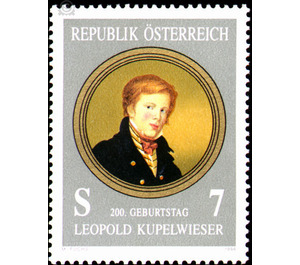200th birthday - Austria / II. Republic of Austria 1996 - 7 Shilling
Theme: Art & Culture
| Country | Austria / II. Republic of Austria |
| Issue Date | 1996 |
| Face Value | 7.00 |
| Color | multi-colored grey |
| Printing Type | Photogravure |
| Stamp Type | Commemorative |
| Item Type | Stamp |
| Chronological Issue Number | 1525 |
| Chronological Chapter | OOS-OE2 |
| SID | 146557 |
| In 59 Wishlists | |
On October 17, 1996, the 200th anniversary of the birth of Leopold Kupelwieser, an important representative of the Austrian late Romantic period. Already in his early years he showed unusual artistic abilities, first in plastic art. The well-known sculptor of Viennese Classicism and Academy Professor Anton Zauner recognized Kupelwieser's talent, and so he was admitted to the Vienna Academy in 1809, where he majored in drawing. Between 1823 and 1825 the artist stayed in Italy as a companion of the Russian aristocrat Alexander Beresin. In Rome he devoted himself to detailed studies of frescoes. Returning to Vienna, Kupelwieser's painting style changed. He used to convince by sharp portraits and a precise capturing of the personality, so now his way of painting became more severe, abrupt. From 1836 on, Kupelwieser worked as a professor at the Vienna Academy. During these years he established his reputation as a religious painter. The result was large-format altarpieces and large-scale fresco cycles. Leopold Kupelwieser died on 17 November 1862 in Vienna.


